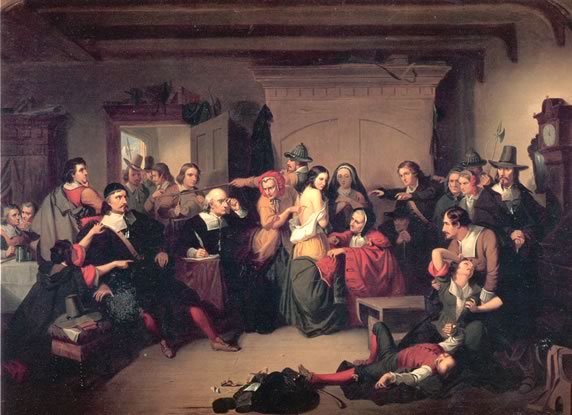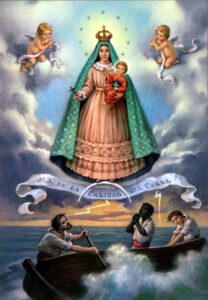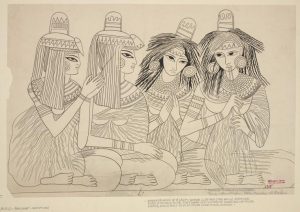Why would adults in Salem, Massachusetts in the 1690s take the accusations of nine year old girls seriously? During the seventeenth century, New England had grown diverse. The people living in the communities were of different backgrounds. But in the 1690’s there was an apparent outbreak of witchcraft. The most famous of these outbreaks was the event in Salem, Massachusetts in 1692 that stirred up the Salem community and soon spread to other communities.
The widespread hysteria over witches was all over the town after an accusation of witchcraft was made in January 1692. A group of young adolescent girls met in the home of Samuel Parris, a Puritan pastor in Salem. The pastor had a nine year old daughter, Betty. Betty and her cousin Abigail were fascinated by the voodoo tales and tricks told to them by the family slave. The family slave, Tituba, was the one whom the little girls had sought after for entertainment.1 It was not long after their time spent with Tituba, when the girls began to behave strangely; seeing visions, babbling at times, and lapsing into trances. The Puritans thought that these behaviors were of witchcraft, as the work of the devil. People in Salem began believing the girls, and charged Tituba and two other village women for practicing witchcraft on them. Two men, John Hathorne and Johnathan Corwin of Massachusetts, were called to do a legal examination of the women. The Puritans followed the Old Testament law. This was how they assessed the examinations. Scripture had a statement that said witches were not able to live. The two men knew exactly what they had to do. The examination was done on these women of Salem by looking for a certain mark on the body: a wart or tit. This specific mark was said to be the place where the devil and his demons would take blood out of the witch.2 Many of the women accused were of lower status in the community.

Research shows most of the accused witches were middle-aged women, widowed, with few or no children. Also, if the woman had been involved with domestic conflicts, they were accused. The women were accused of crimes and appeared to be dangerous by their neighbors. Women in Salem who inherited or possessed land were also accused of witchcraft.3 The accusations towards these women were out of the ordinary and seemingly wrong. One must first think about the view of women during this time. They were undermined and portrayed as having no power or knowledge of such things; they were subservient to the men in the community. Not only were low class women accused of witchcraft, but as time passed, superior women were accused as well.4
On October 29th, the Salem Witch Trials were called to an end. Governor Phips dismissed the Court and that marked the end to the witch hunt craze. Many were disappointed about the ending of the trials, but many were glad to return to work.5 The community in Salem blamed Pastor Parris for letting the innocent die. The people of the Salem church also voted to void his salary. In the following years, those family members of the deceased were restored their good names. The families were awarded a compensation for all the financial loses they went through during such tragic times. Increase Mather, a pastor of the Boston Puritan Church, wanted the people to do away with the court because he believed they put innocent people to death.
The Witch trials took on an important role in American History. The trials became a tragic and memorable moment in history. Generational, racial, and sexual hostility, opposition to law, social stresses, and food poisoning were all causes as to why the people had anxieties that found release in the witch hunt craze. The witch hunts became searches for scapegoats; the community leaders were looking for anyway possible to ease the community’s anxieties.6
- Kenneth P. Minkema, “In the Devil’s Snare: The Salem Witchcraft Crisis of 1692,” The Christian Century, no. 8 (2003): 37. ↵
- Salem Press Encyclopedia, January 2015, s.v. “Salem Witchcraft Trials,” by Warren M. Billings and Kimberly Manning. ↵
- Alan Brinkley, American History, 15th ed., vol. 1: to 1865 (2 Penn Plaza, New York, NY 10121: McGraw Hill Education, 2015), 86-87. ↵
- Salem Press Encyclopedia, January 2015 s.v. “Salem Witchcraft Trials,” by Warren M. Billings, Kimberly Manning. ↵
- Salem Press Encyclopedia, January 2015 s.v. “Salem Witchcraft Trials,” by Warren M. Billings, Kimberly Manning. ↵
- Salem Press Encyclopedia, January 2015 s.v. “Salem Witchcraft Trials,” by Warren M. Billings and Kimberly Manning. ↵



178 comments
Aaron Onofre
It is crazy to think that start of the Salem Witch Trials was because of two little girls. The story of these girls caused a mass hysteria and death of many innocent women murdered based off of false accusations. These girls could have been telling the truth or just going along with a story they had created. I believe the rash decisions of the community is largely responsible for the death of these women.
Perla Ramirez
It crazy how the accusations of two nine year olds had on a slave which resulted in her death. They believed they could see things through a different lens after she was telling them stories on it. But what is even more sad is that they had suspisions on the mostly women that were part of the lower status community, widowed, middle-aged, and had little to now children.
Joseph Chi
Hey Oscar, I think you did a really interesting topic for the colonial era. Most schools do not teach us about the Salem Witch Trials in the thirteen colonies. Especially the fact that it originated from two little 9 year old girls. I think you made it very interesting and very knowledgeable instead of just giving a small and simple jist.
Santos Mencio
The Salem witch trials is a fascinating period, and this article certainly does it justice. It seems like there was a distinct targeting of social pariahs during the trials, as well as the targeting of those who possessed land that the accusers may have wanted. Religion is one of humanity’s oldest excuses to do terrible things, and this article captures that perfectly.
Matthew Gallardo
Its shocking to see that a simple body feature could make someone a witch, and that this was started by 2 girls will always be surprising to me. this article on the Salem witch trials was short and easy to read, making it a good reading for those who want to start off the subject, while still diving into the causes and law of the time, covering it as much as it needs for people to understand the subject, but allowing people who are interested to continue searching on the subject.
Santiago Sabogal
This article written by Oscar Sepulveda tells us about uno of the most horrendous chapters of the colonies in the U.S, the indiscriminate persecution of “witches” in Salem ending the 17th century. This reading lets us see how it was back then and how women were misplaced and mistreated in the puritans society. Women were in danger and had no guarantees, since any man that just disliked her or wanted to kill her, all he had to do was to acusate her from witchcraft and with no hesitation, they would burn her alive. This tragic chapter led to hundreds of deaths, most of the women were low and middle class, but still sometimes rich women would also be burned.
Seth Roen
This article on the Salem Witch Trial was a rather strange series of early American historical events. I like it strange how some people could be so paranoid were back in the 17th century. Granted, the lack of food and food contaminated with fungus and frontier fears, the people were scared and needed a scapegoat for all their problems. Sadly it was toward those, at the time, who did not defend themselves.
Daniela Iniguez-Jaco
Wow! I could not stop reading, this was well-written and interesting to read about! I enjoy getting to read about the Salem Witch Trials, it must have been a horrible time to be alive, but getting to read about it makes me realize how politics and religions do not mix well. I did not know that if a woman possessed land that she would be accused of witchcraft! It is crazy to think that a woman doing a “man’s role” could have a horrible ending.
Amelie Rivas-Berlanga
The article has a great hook! I never get tired of reading and learning new things about the witch trials. I would have loved to see some of the ways people were executed during the witch trials in the article. It is clear, quick, and simple. I like that at the end of the article the author explains the importance that the event had on history.
Aidan Fitzgerald
This article was very interesting as I myself don’t have much background knowledge on the Salem Witch-trials. You do a good job of staying on topic in this article and I can only help to relate this to things occurring in our present society. These times seemed extremely irrational and the people who lived during this time were very adamant about their religion and beliefs. Some of their values seem to very extreme and you do a great job in this article describing the role religion played in politics. Many people in this time period were arrogant to different beliefs and it seems as if this is a prime example of how feminism and beliefs were much different than times we live in today. Overall great article and very informative.